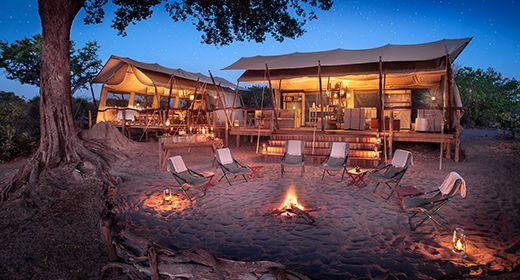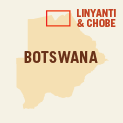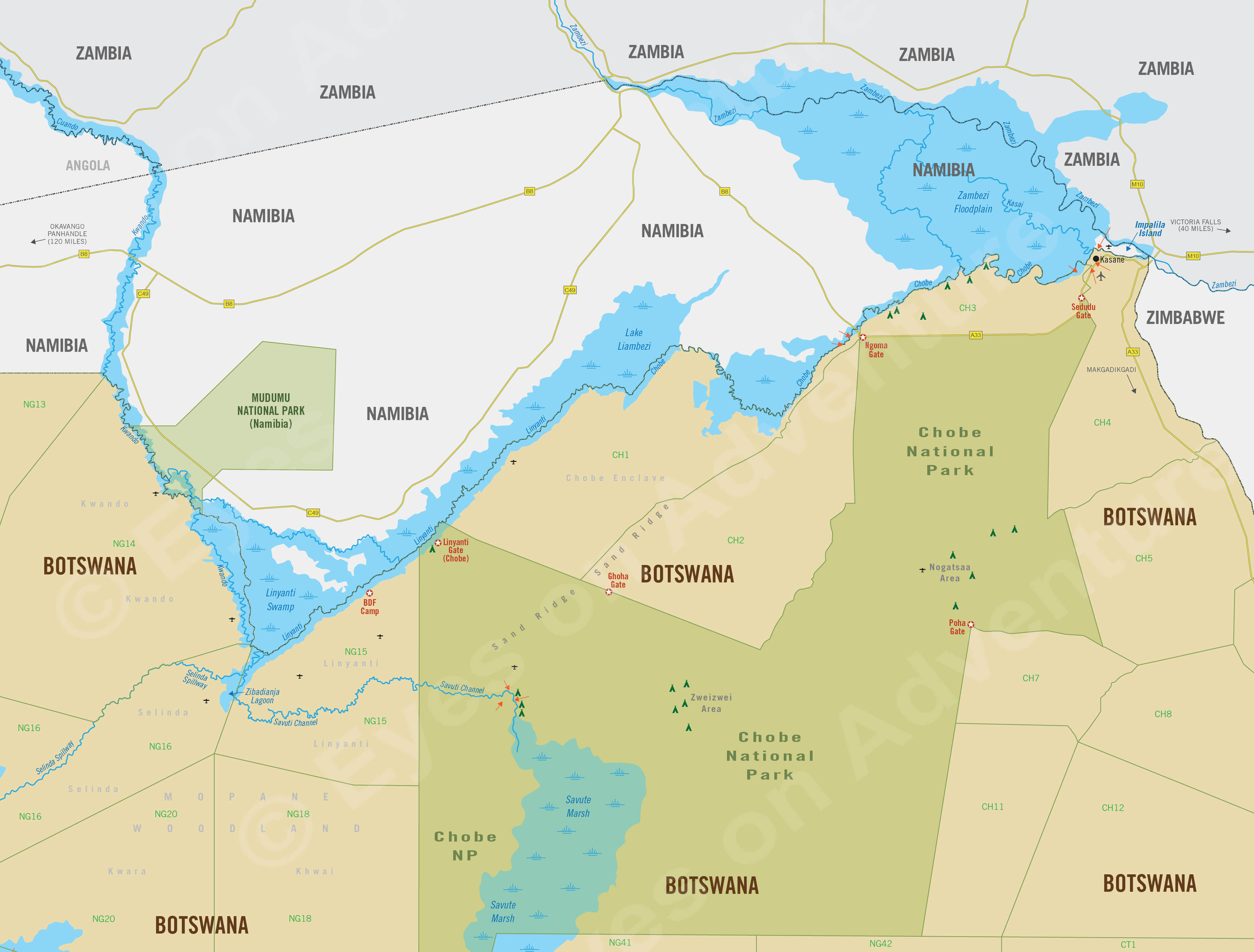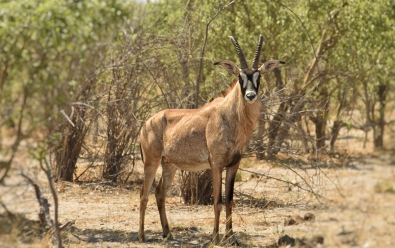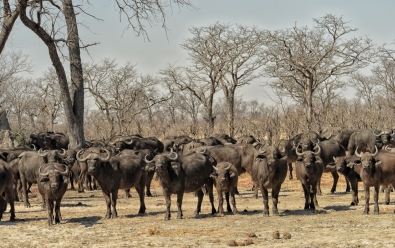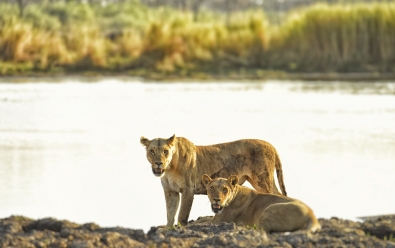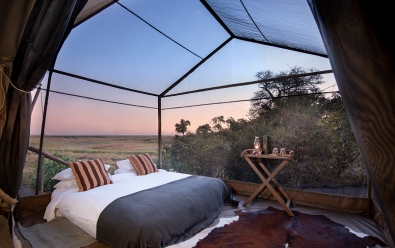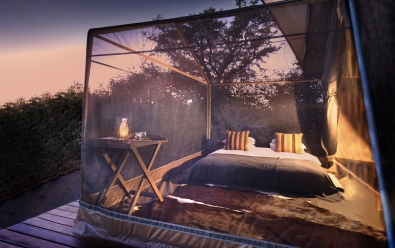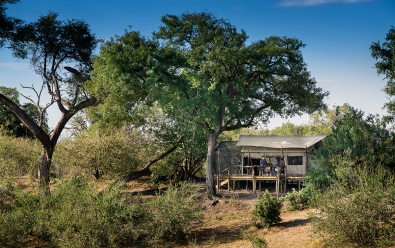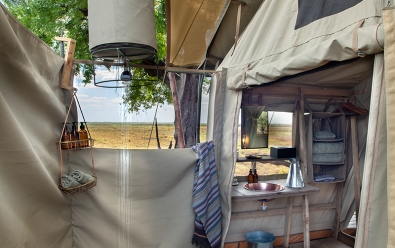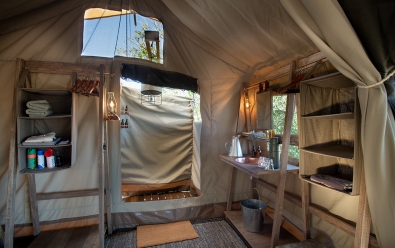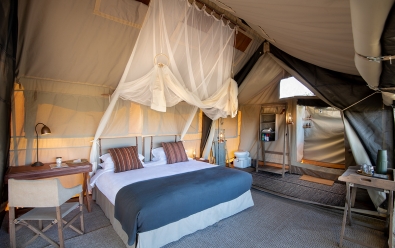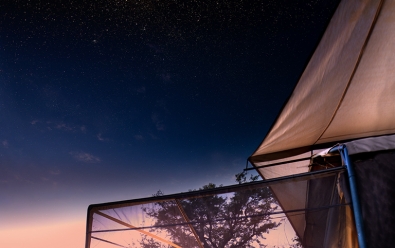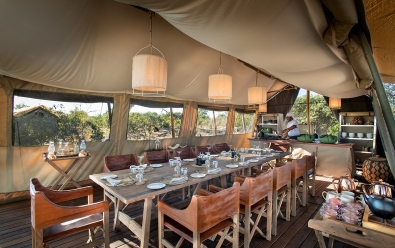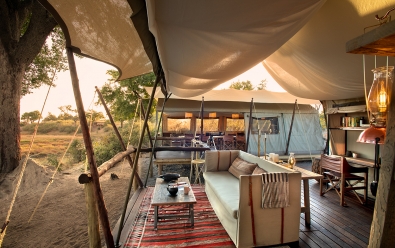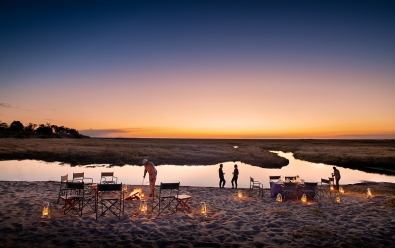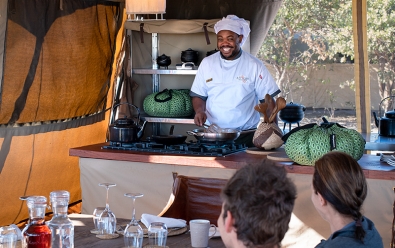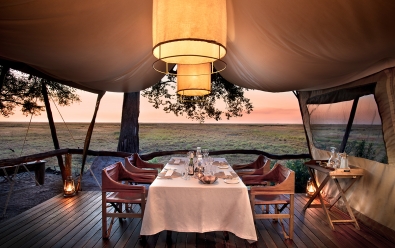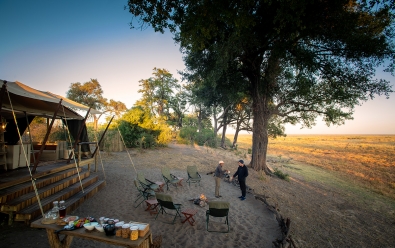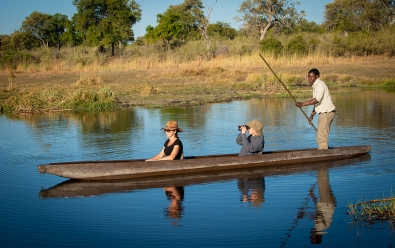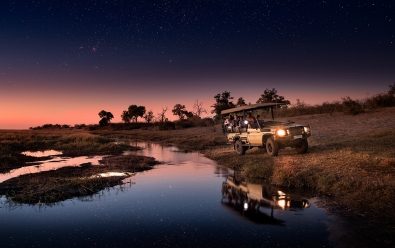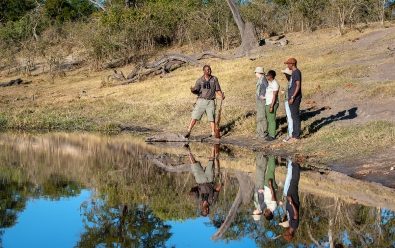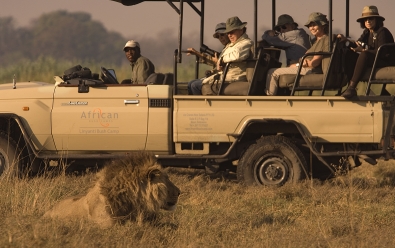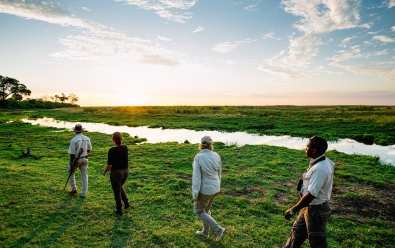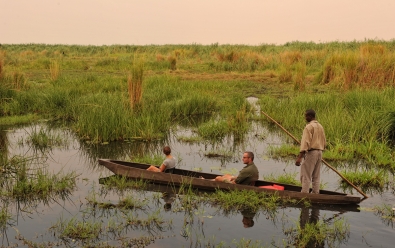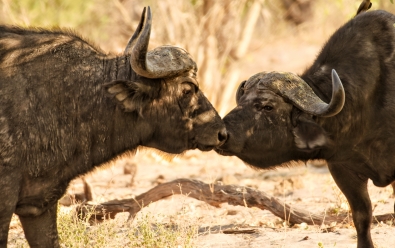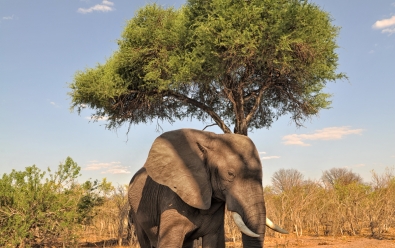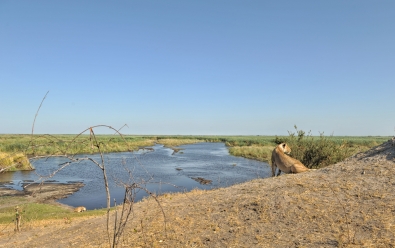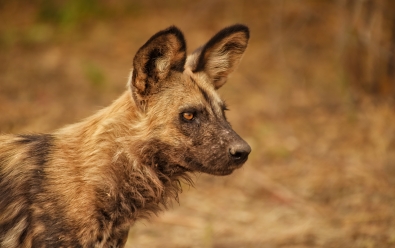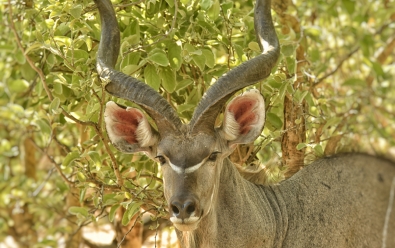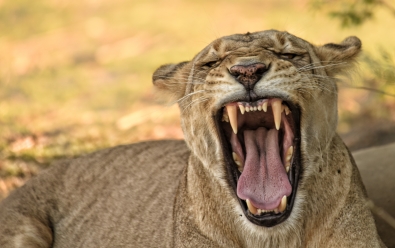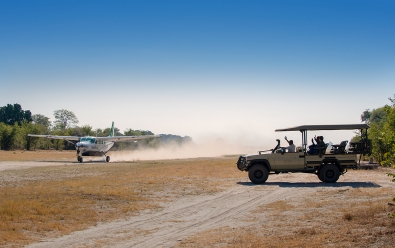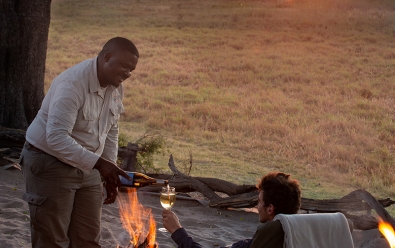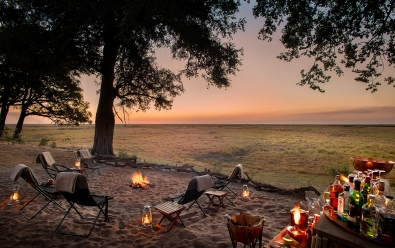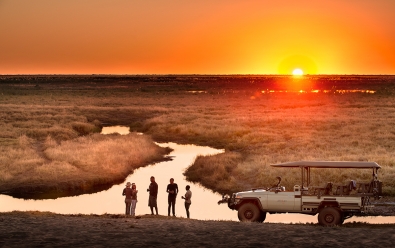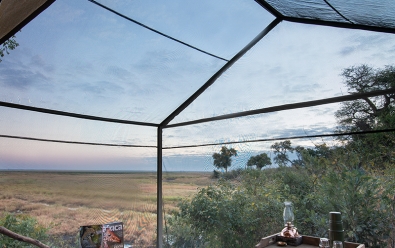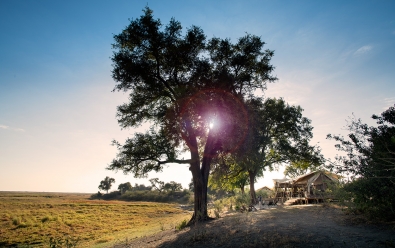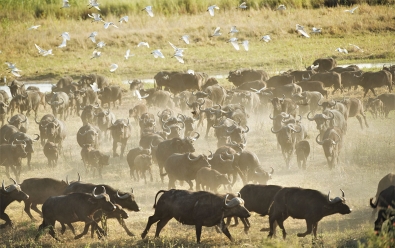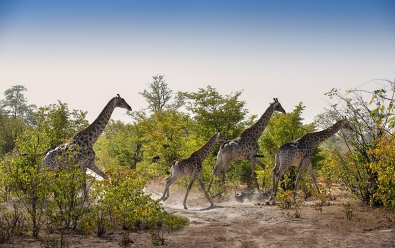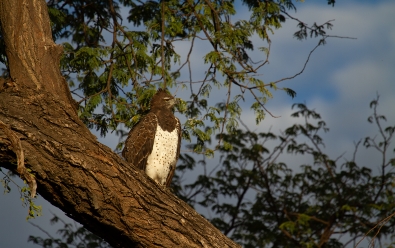Linyanti Expeditions Camp
Highlights
- Small, seasonal, classic-style camp located in a private concession.
- Excellent wildlife area, particularly during the dry season.
- Day and night safari drives, walking, mokoros.
- Located on the Linyanti River, which attracts diverse wildlife.
Location
- CH1 Private Concession
- Chobe Enclave
- Northern Botswana
Linyanti Expeditions Camp is a small, seasonal camp that evokes a safari experience like those of the early explorers and offers an abundance of wildlife.
Linyanti Expeditions Camp, along with African Bush Camps' slightly more upscale Linyanti Bush Camp and Linyanti Ebony Camp, are located on the northern boundary of Botswana in a large private area within the Chobe Enclave, which borders the western reaches of Chobe National Park.
This area offers good wildlife viewing all year, but is best during the dry seasons months from June thru October, when the Linyanti River, which all three camps overlook, attracts a great number and diversity of mammals and birds that come to drink at the only source of fresh water for many miles.
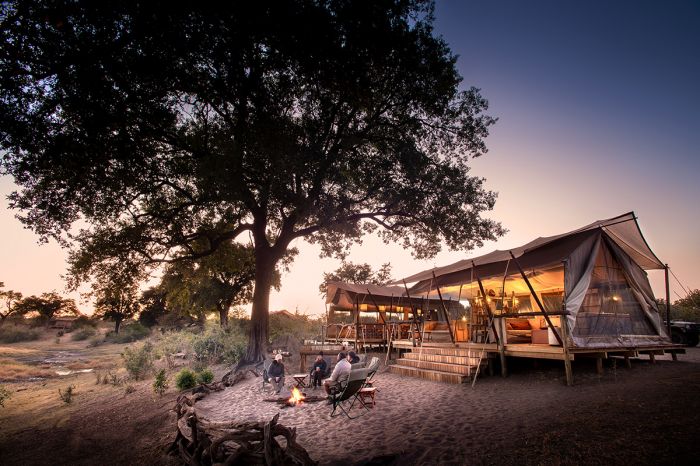
The main camp area at Linyanti Expeditions Camp.
The Linyanti River, which becomes more of a wetland than a flowing river during the dry season, is the focal point for the camp and the wildlife activities offered. Guests may choose from a variety of activities, including game drives in customized, open-sided Land Cruisers, water-based excursions on the traditional 'mokoro' (a long canoe propelled by a 'poler' guide who stands at the rear), and nature walks.
The camp has 6, Meru-style, safari tents that are simple and not over-the-top, but offer all needed creature comforts. The unique design of the tents features a "Star-Suite" extension enclosed by mesh screening that offers sleeping beneath the stars from within the tent.
The guest tents also offer comfortable beds (twin or double setup), an outdoor veranda overlooking the Linyanti river/wetland, and en-suite facilities with a bucket-shower, wash basin, and chemical flush-toilet.
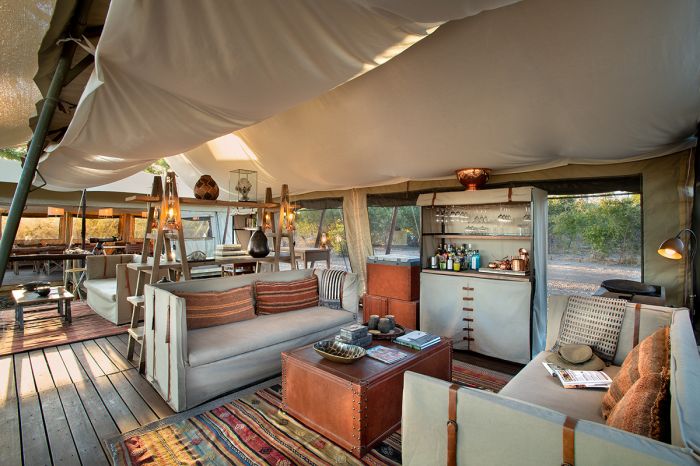
Main guest area tents at Linyanti Expeditions Camp.
The main guest area includes two canvas-tented structure, one that is used for dining and features an interactive kitchen, and the other comprising a comfortable lounge, library, and bar. The main area's focal point is the campfire, which is ideal for evening drinks, snacks, and conversation about the day's adventures.
The camp operates primarily on solar energy, but a generator provides a backup power source and there is a charging station for electronics in the main guest area.
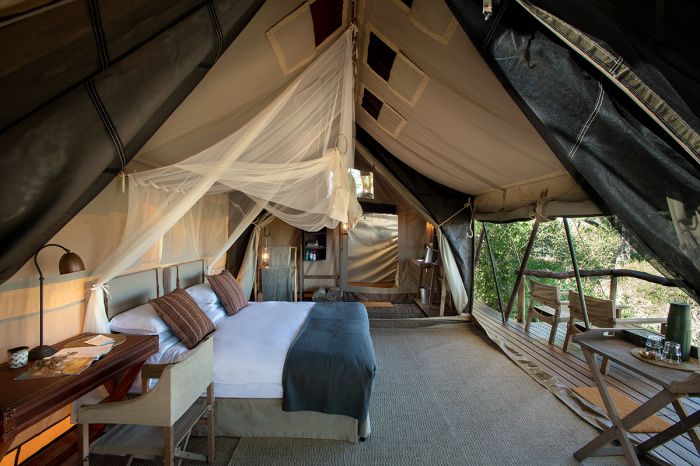
Guest tent interior at Linyanti Expeditions Camp.
Linyanti Expeditions Camp is owned and operated by African Bush Camps (ABC), a company founded by a professional African safari guide, who has a passion for protecting remote spaces and the wildlife that lives there.
African Bush Camps owns safari camps in Botswana, Zimbabwe, and Zambia. The ABC camps are fully sustainable, with minimal impact on the environment. The African Bush Camps Foundation runs local projects that empower the local communities wherever they operate safari camps. The company's aim is to conserve and preserve wildlife and natural areas in Southern Africa.
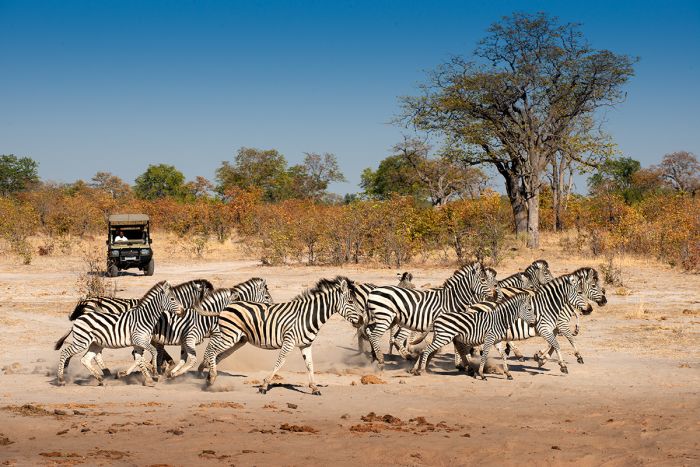
Game drive at Linyanti Expeditions Camp.
the Northern Reserves (Linyanti, Kwando, Selinda)
Located directly to the north of the Okavango Delta are several superb wildlife reserves: the Linyanti, Selinda, Kwando, and the Linyanti concession of the Chobe Enclave. All of these reserves offer superb game viewing in huge wilderness areas with very low tourist numbers. Each of the reserves has a number of safari camps and they all pair superbly with a visit to one more more camps in the Okavango. Daily charter flights are available from any of the camps in the Okavango Delta or elsewhere in northern Botswana.
Similar to the Okavango Delta, the northern reserves receive water from rivers fed by rains in northern Angola, the amount varying year to year. The Kwando River forms the border between Botswana and Namibia, and much like the Okavango River further west, it also empties into a trough of Kalahari sand, creating the Linyanti Swamp, a much smaller version of the Okavango Delta. The Linyanti Swamp empties eastward into the Linyanti River, which becomes the Chobe River further to the east.
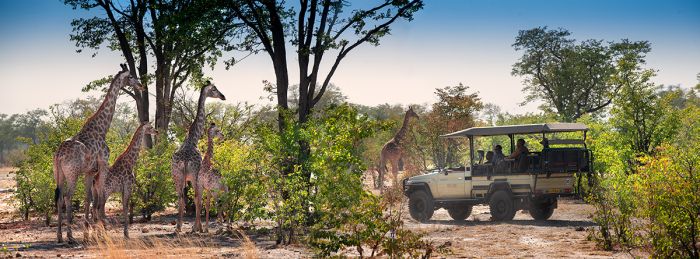
Giraffes seen on a game drive at Linyanti Expeditions Camp.
In some years, and usually in multi-year cycles, the rain water flowing down the Kwando River is sufficient enough to cause the Linyanti Swamp to overflow to the south, where it may flow east into the Savuti Channel or southwest into the Selinda Spillway. The Savuti Channel empties into the Savute Marsh in Chobe National Park. The Selinda Spillway flows back into the northern part of the Okavango Delta.
Both of these waterways have historically gone through long periods of total dryness, becoming rich grasslands, and then suddenly flowing with water again, bringing rich sediments and new water along their courses. Like the Okavango, water flows are dynamic over time, with rains in the Angolan highlands and tectonic movements far beneath the surface of northern Botswana affecting the quantity and direction of the water in these river systems.
Away from the major rivers in the northern portion of these reserves, the southern portion of the northern reserves is dominated by dry woodland, consisting of Kalahari apple-leaf bush, mopane trees and Acacia trees on deep Kalahari sand. Elephants wander through as they travel between the Okavango and the northern rivers, and there are impala, greater kudu, roan antelope, sable antelope, but this area is mostly not used for safaris, with the safari camps located along the waterways to the north.
Wildlife viewing along the waterways in the northern reserves is outstanding, particularly between July and late October, when the bush is dry and the animals stay close to the permanent water. Elephants gather in large numbers at this time and head to the waterways to drink twice daily, sometimes swimming and playing in the deeper water. Herds of buffalo, zebra, and impala are also present in good numbers. Other herbivores include include greater kudu, giraffe, red lechwe, tsessebe, waterbuck, blue wildebeest, and warthog.
Common predators include lion, leopard, spotted hyena, black-backed jackal, and African wild dog. The northern reserves are one of the best places in Africa to see the wild dogs, which have their young around June each year, the pups are truly something to see if you get lucky. Cheetah are here in modest numbers and can be seen in the open grassland areas. Hippo and crocodile are abundant in the Kwando, Linyanti, and Chobe Rivers, as well as in the Linyanti Swamp area. Chacma baboon and vervet monkey are found in the riparian forests.
Birding in the northern reserves is outstanding, with a diverse mix of grassland, woodland, raptors, and water species found. A typical safari day can easily produce 100 species.
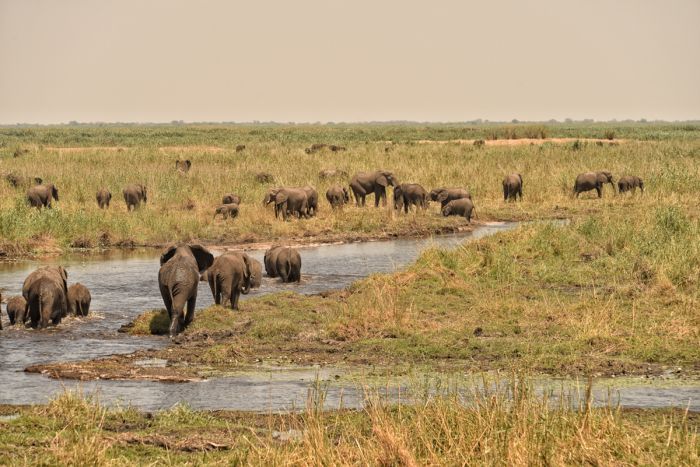
Elephants along the Linyanti River wetland at Linyanti Ebony Camp.
ROOMS INCLUDES & EXCLUDES CHILDREN FACILITIES ACTIVITIES
Accommodation
6 guest accommodations in total comprising:
- 6 twin-bedded, Meru-style, canvas tents, each with two three-quarter beds (convertible to a double bed) and a small, outdoor deck with seating. The unique tents also feature a "Star-Suite" extension that offers sleeping beneath the stars from within the tent.
All the tents feature en-suite facilities that include an open-air, enclosed bucket-shower, single-basin vanity, and a chemical flush-toilet.
The guest tents are constructed on slightly-elevated, wooden platforms with sand footpaths leading to the main camp area.
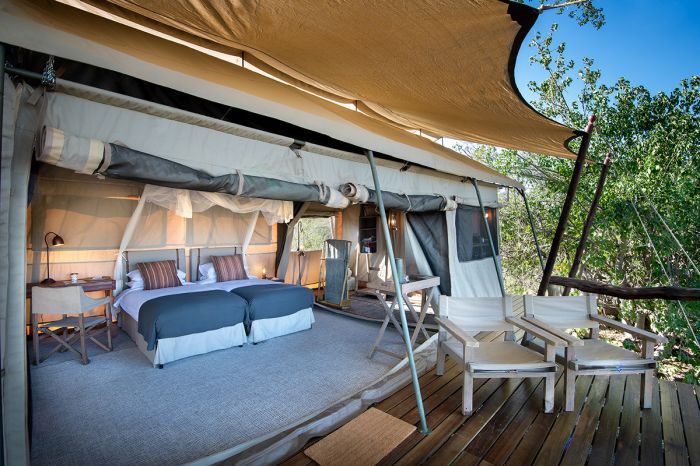
Guest tent at Linyanti Expeditions Camp.
Other items and features in the guest tents include:
- Writing desk and chair.
- A "Star-Suite" extension with mesh walls and ceiling and a floor-level mattress for a 'sleep-under-the-stars' experience within the comfort of the tent.
- Mosquito netting over the beds.
- Veranda with deck chairs.
- Multi-plug charging station in the main camp area only.
- Personal amenities, including laundry basket, liquid soap, body wash, shampoo and conditioner, insect repellent, insect spray, room spray, vanity kit with cotton-tip swabs and cotton wool pads, shower cap, and umbrella.
Linyanti Expeditions Camp can accommodate a maximum of 12 guests in total: 2 guests in each of the guest tents.
Includes & Excludes
Includes:
- All meals and local beverages including wines, spirits and liqueurs, but excluding premium imported brands and Champagne.
- Twice-daily safari activities including game drives in open game-viewing vehicles, nature walks, mokoro outings (subject to water levels), and other scheduled camp activities (all accompanied by experienced guides).
- Laundry services are provided on a daily basis (weather permitting, items will be returned on the same day). Laundry is dried by the sun and on most days any laundry placed out in the morning will be returned by the evening.
- Linyanti airstrip road transfers.
- Tourism Levy & VAT.
Excludes:
- Premium imported beverages and Champagne.
- Cultural tour of a local Linyanti village.
- Any applicable wildlife fee, park fee, reserve fee, concession fee, other land-use fee.
Single Supplement
A single supplement will apply for any room booked by a single traveler; please ask us for pricing.
Children
Children 12 years and older are accommodated at Linyanti Expeditions Camp.
- Children aged 16 years and older will pay applicable adult rates and can be accommodated in a separate tent or sharing with a parent.
- Families with children will be accommodated in the same vehicle as other guests for game drives. Private vehicles are an option (subject to availability and at additional cost).
- Walking activities are available to guests aged 16 years and above.
- Mokoro activities are available to guests aged 16 years and above.
- All children must be supervised by their parents, as the camp is not fenced and is located in an area with wild animals.
Facilities
Linyanti Expeditions Camp is situated in a private concession bordering Chobe National Park and along the bank of the Linyanti River, which seasonally becomes more of a marshland than a flowing river. The permanent source of water attracts wildlife and birds, particularly during the dry months between June and October, but provides excellent wildlife viewing all year.
The main camp area consists of two canvas-tented structures supported by wooden beams and constructed atop a slightly elevated wooden deck. One of the canvas hubs is for indoor dining and includes an interactive kitchen; the other is a relaxing guest lounge and library that also includes the bar.
The main tented area opens the campfire area on the ground, with the Linyanti River wetland just beyond.
Main guest area facilities include:
- Two canvas-tented hubs: one is the lounge, library, and bar, while the other is used for dining. Both are open to the front (with roll-down flaps in case of wind or rain) and constructed atop a slightly-raised, wooden deck.
- Campfire area.
- Guest toilet in the main area.
Activities
Activities included in the rate:
- Day and night game drives in 4x4 Land Cruisers.
- Birding.
- Guided nature walks.
- Mokoro (traditional canoe) outings on the Linyanti River, water-levels dependent.
Optional activities at additional cost:
- Private activities are on offer (subject to vehicle availability, which needs to be booked in advance).
- Scenic helicopter flights ranging in duration from 30, 45 to 60 minutes. Offered seasonally, from April thru November.
- Cultural tour of a local Linyanti village.
Example of a typical day:
- Early morning wake-up call. Morning wake-up and activity times vary according to the seasons, activities on offer, and wildlife sightings.
- Light breakfast before departing on the morning activity.
- Return to camp for a meal and rest period.
- Meet for afternoon tea and snacks (savory and sweet choices) before departing on the activity.
- Return to camp - freshen up or meet for drinks, followed by dinner.
- Enjoy a nightcap or discussion around the fire before retiring.
Great Good Fair Poor
- Jan
- Feb
- Mar
- Apr
- May
- Jun
- Jul
- Aug
- Sep
- Oct
- Nov
- Dec
WHEN TO GO
The Linyanti region of northern Botswana offers excellent wildlife viewing opportunities throughout the year, but there are definitely seasonal variations in terms of weather and the densities of wildlife that may be a consideration when planning your visit.
The high season in terms of tourist demand is during the dry months between June and October. The latter part of the rainy season (February through April) is the low season.
The winter (June through August) is dry and cool and wildlife may be easier to locate as rain water is evaporating and the Linyanti, Kwando, and Chobe rivers and and substantial waterholes become more frequently visited by the animals as water becomes more scarce.
During the middle and later stages of the rainy season, the grass becomes tall and the bush becomes lush and thick, which makes for lovely colors, but makes spotting wildlife more difficult.
Linyanti Expeditions Camp is a seasonal camp, open from 01-May thru 31-October.
Summer / Rains
Northern Botswana, including the Linyanti region receives most of its rain between December and February, which is the summer season. November and December are superb months to visit the Linyanti, with only occasional rainstorms and most rain coming in short showers, bringing welcome relief to the thirsty land after the dry season.
January and February typically experience afternoon downpours on most days, but all-day rains are uncommon. By the middle of March, the rains become much less frequent and the grass and bush have grown long and thick. Mornings become cooler by the end of March.
In spite of being summer, the rains keep temperatures from becoming overly hot, although humidity and insect life are at their peak. Days are mostly overcast or partially cloudy, with dramatic skies and a lovely green color to the landscape. Afternoon temperatures average 88°F (31°C), but mornings are very comfortable at around 65°F (19°C).
Baby animals are in abundance, especially impala lambs and warthog piglets. Migratory birds arrive to breed and dramatically increase the number of species and overall numbers, particularly in the lagoons and pans, which are full of rain water and food for the aquatic species.
Unlike the dry months (May through October), when the middays can be very warm, causing wildlife to minimize activity and seek shade from around 10am til mid-afternoon, the overcast skies during the summer often mean that animals are active throughout the day, offering many more hours of game viewing.
Autumn
March, April and May are Fall season months and the beginning of the dry season in the Linyanti, with rains very uncommon from around mid-March. The landscape is still lush and green, with sunny days and comfortable temps; afternoons average 84°F (29°C). Mornings are comfortable, but a fleece and base layer may be needed for the first hours on game drive.
Migrant birds fly north and water in the lagoons and rain pans is drying up. Permanent waterways, including the Kwando, Linyanti, and Chobe rivers, are actually rising however, as the 'flood' water from the Angolan highlands is now reaching into northern Botswana. As a result of the rains abating and the waterholes away from the river becoming dry, animals begin to spend their time closer to these rivers, and wildlife sightings become better and better.
Morning temps are around 54°F/12°C and afternoons average 79°F/26°C.
Winter / Dry Season
June through August is winter and the vegetation is drying and going dormant. The water in the Linyanti/Chobe river system is peaking but the surrounding landscape is mostly brown and yellow. Dust and sand particles in the air is on the rise. Game viewing is superb, with elephant and buffalo herds congregating along permanent water.
Mornings can be chilly to very cold at around 45°F (7°C). Warm clothes, including winter hat and gloves are needed for the open-air game drives. Dress in layers, as the temps do rise quickly during the day, with middays reaching 79°F (26°C).
Wildlife sightings are superb in the Linyanti during the dry winter months.
Spring
September and October are the driest months as the landscape and animals eagerly await the coming rains. Game viewing is phenomenal, with all rain pans now completely dry and animals are congregating around permanent waterways, particularly along the Linyanti, Kwando, and Chobe Rivers. The grass and vegetation are very dry.
Days are warm, sunny, and often cloudless and by mid-morning, most animals are seeking shelter in the shade and awaiting the evening temps to drop. October can be brutally hot and dusty and even smoky as sporadic grass fires can occur.
Safari camps are mostly full to capacity, with guests adhering to guide books saying this is the only time to visit (not true of course). Temperatures in October can easily reach 95°F (35°C) or even hotter. Game viewing is superb.




